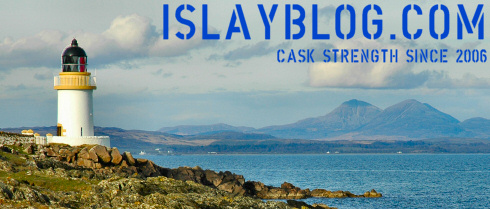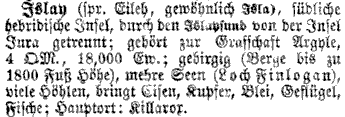IslayBlog.com -> 2007 ->

Tuesday, 02/Oct/2007
Islay in Old German Encyclopedia

When I find an old encyclopedia or something similar on the web one of the first topics I usually check out is Islay. Thanks to The Cartoonist (yes, that Cartoonist) I recently found Zeno, an online repository of among other things old German dictionaries and encyclopedias. Naturally I took a look for something about Islay. I found something in Pierer's Universal-Lexikon from 1857:
Islay (spr. Eileh, gewöhnlich Isla), südliche hebridische Insel, durch den Islaysund von der Insel Jura getrennt; gehört zur Grafschaft Argyle, 4 QM., 18,000 Ew.; gebirgig (Berge bis zu 1800 Fuß Höhe), mehre Seen (Loch Finlogan), viele Höhlen, bringt Eisen, Kupfer, Blei, Geflügel, Fische; Hauptort: Killarox.
From: Islay - Zeno.org. Translated into English this means as much as:
Islay (pronounced Eileh, usually Isla), southern Hebridean island, separated from the Isle of Jura by the Sound of Islay; belongs to the county of Argyle, 4 QM. (AG: don't know what QM means, explanations welcome!), 18,000 inhabitants, hilly (mountains up to 1800 feet high), several lakes (Loch Finlogan), many caves, supplies iron, copper, lead, poultry, fish; Main settlement: Killarox.
Considering this was published in 1857 it seems to be quite comprehensive for a small island probably almost no-one in Germany will have heard of back then. Some slight inaccuracies, the highest hill on Islay is Beinn Bheigier at 1611 ft and I assume Killarox should be Killarow, the predecessor to Bowmore. Loch Finlogan should be Loch Finlaggan, unless Finlogan is some ancient spelling I haven't heard of yet.
I don't know what ‘4 QM’ means though, any suggestions from my (German or other) readers?
Advertising
Navigation
[Previous entry: "A New Start on Islay"] [Home] [Next entry: "Mhairi Muir from Islay in Action"]